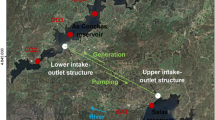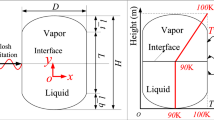Abstract
In this paper, the thermal behavior of a vertical domestic hot water storage tank during the dynamic mode was studied. A 3D computational fluid dynamic (CFD) model was performed using the commercial software package Fluent v6.3. The proposed model was validated with experimental data obtained from the literature. The results of the simulation served to analyze the flow characteristics and the thermal stratification evolution during charging and discharging phases. This study was further extended to explore the effect of varying tank position (horizontal/vertical) on the system performance. A numerical comparison between the two configurations was carried out and performance parameters such as discharge efficiency, Richardson number and stratification efficiency were calculated. A major finding of the above analysis was the presence of two regions of increased thermal mixing in the horizontal tank. The contribution of these two recirculation zones on the destruction of the thermal stratification resulting in a decrease of the overall performance was demonstrated.
Similar content being viewed by others
References
Altuntop N, Arslan M, Ozceyhan V, Kanoglu M (2005). Effect of obstacles on thermal stratification in hot water storage tanks. Applied Thermal Engineering, 25: 2285–2298.
Andersen E, Furbo S, Fan J (2007). Multilayer fabric stratification pipes for solar tanks. Solar Energy, 81: 1219–1226.
Blandin D (2010). Modélisation et validation expérimentale de nouveaux concepts de ballons solaires à forte stratification. Doctoral thesis, L’institut nationale des sciences appliquées de Lyon, France.
Castell A, Medrano M, Solé C, Cabeza L (2010). Dimensionless numbers used to characterize stratification in water tanks for discharging at low flow rates. Renewable Energy, 35: 2192–2199.
Consul R, Rodrigues I, Perez-Segarra CD, Soria M (2004). Virtual prototyping of storage tanks by means of three-dimensional CFD and heat transfer numerical simulation. Solar Energy, 77: 179–191.
Davidson J, Adams D, Miller J (1994). A coefficient to characterize mixing in solar water storage tanks. Solar Energy Engineering, 116: 94–99.
Fernàndez-Seara J, Uhia F, Sieres J (2007). Experimental analysis of a domestic electric hot water storage tank. Part II: Dynamic mode of operation. Applied Thermal Engineering, 27: 137–144.
Gasque M, González-Altozano P, Maurer D, Moncho-Esteve IJ, Gutiérrez-Colomer RP, Palau-Salvador G, García-Marí E (2015). Study of the influence of inner lining material on thermal stratification in a hot water storage tank. Applied Thermal Engineering, 75: 344–356.
Haller M, Yazdanshenas E, Andersen E, Bales C, Streicher W, Furbo S (2010). A method to determine stratification efficiency of thermal energy storage processes independently from storage heat losses. Solar Energy, 84: 997–1007.
Han Y, Wang R, Dai Y (2009). Thermal stratification within the water tank. Renewable and Sustainable Energy Reviews, 13: 1014–1026.
Ievers S, Lin W (2009). Numerical simulation of three-dimensional flow dynamics in a hot water storage tank. Applied Energy, 86: 2604–2614.
Jordan U, Furbo S (2005). Thermal stratification in small solar domestic storage tanks caused by draw-offs. Solar Energy, 78: 291–300.
Kaloudis E, Grigoriadis DGE, Papanicolaou E, Panidis T (2013). Large eddy simulations of turbulent mixed convection in the charging of a rectangular thermal storage tank. International Journal of Heat and Fluid Flow, 44: 776–791.
Kenjo L, Inard C, Caccavelli D (2007). Experimental and numerical study of thermal stratification in a mantle tank of a solar domestic hot water system. Applied Thermal Engineering, 27: 1986–1995.
Khurana T, Prasad B, Ramamurthi K, Murthy S (2006). Thermal stratification in ribbed liquid hydrogen storage tanks. International Journal Hydrogen Energy, 31: 2299–2309.
Lavan Z, Thompson J (1977). Experimental study of thermally stratified hot water storage tanks. Solar Energy, 19: 519–524.
Li S, Zhang Y, Li Y, Zhang X (2014). Experimental study of inlet structure on the discharging performance of a solar water storage tank. Energy and Buildings, 70: 490–496.
Mawire A (2013). Experimental and simulated thermal stratification evaluation of an oil storage tank subjected to heat losses during charging. Applied Energy, 108: 459–456.
Michael W, Wrobel J (2009). Thermodynamic optimization of a stratified thermal storage device. Applied Thermal Engineering, 29: 2344–2349.
Nizami DJ, Lightstone MF, Harrison SJ, Cruickshank CA (2013). Negative buoyant plume model for solar domestic hot water tank systems incorporating a vertical inlet. Solar Energy, 87: 53–63.
Njoku HO, Ekechukwu OV, Onyegegbu SO (2014). Analysis of stratified thermal storage systems: An overview. Heat Mass Transfer, 50: 1017–1030.
Panthalookaran V, Heidemann W, Müller-Steinhagen H (2007). A new method of characterization for stratified thermal energy stores. Solar Energy, 81: 1043–1054.
Rezaie B, Reddy BV, Rosen MA (2014). Energy analysis of thermal energy storages with grid configurations. Applied Energy, 117: 54–61.
Rosen M (2001). The exergy of stratified thermal energy storages. Solar Energy, 71: 173–185.
Rosen M, Tang R, Dincer I (2004). Effect of stratification on energy and exergy capacities in thermal storage systems. International Journal of Energy Research, 28: 177–193.
Savicki D, Vielmo H, Krenzinger A (2011). Three-dimensional analysis and investigation of the thermal and hydrodynamic behaviors of cylindrical storage tanks. Renewable Energy, 36: 1364–1373.
Shin MS, Kim HS, Jang DS, Lee SN, Lee YS, Yoon HG (2004). Numerical and experimental study on the design of a stratified thermal storage system. Applied Thermal Engineering, 24: 17–27.
Toyoshima M, Okawa S (2013). An effect of a horizontal buoyant jet on the temperature distribution inside a hot water storage tank. International Journal of Heat and Fluid Flow, 44: 403–413.
Zachár A (2013). Investigation of a new tube-in-tube helical flow distributor design to improve temperature stratification inside hot water storage tanks operated with coiled-tube heat exchangers. International Journal of Heat and Mass Transfer, 63: 150–161.
Author information
Authors and Affiliations
Corresponding author
Rights and permissions
About this article
Cite this article
Abdelhak, O., Mhiri, H. & Bournot, P. CFD analysis of thermal stratification in domestic hot water storage tank during dynamic mode. Build. Simul. 8, 421–429 (2015). https://doi.org/10.1007/s12273-015-0216-9
Received:
Revised:
Accepted:
Published:
Issue Date:
DOI: https://doi.org/10.1007/s12273-015-0216-9




